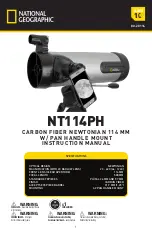
29
c.
Custom
: Allows entry of user-defined tracking rates.
Reverse L/R:
Reverses the functions of the Left and Right Arrow keys (
i.e., the Right key
moves the telescope to the left
).
Reverse UP/DOWN:
Reverses the functions of the Up and Down Arrow keys (
i.e., the Up
key moves the telescope down
).
Reverse L/R:
Reverses the functions of the Left and Right Arrow keys (
i.e., the Right key
moves the telescope to the left)
.
Reverse UP/DOWN:
Reverses the functions of the Up and Down Arrow keys (
i.e., the Up
key moves the telescope down)
.
Calibrate Sensors:
This menu allows you to improve your telescope's pointing accuracy
to alignment stars. It calibrates to correct slight mechanical misalignment due to transport,
vibration, or aging.
When this menu is selected, the telescope slews to Polaris. AutoStar then prompts you to
center Polaris and to press ENTER. AutoStar uses the position of Polaris to fine tune the
position of North and also for detecting level.
Quiet Slew
: Sets the maximum slew rate to 1.5° for quieter operation.
Max Elevation
: Allows you to enter a value in degrees that sets a limit as to how far the
optical tube can swing upward during a programmed slew. (Note that it does not prevent
you from performing a manual slew past this limit.) This is
useful when you have a camera or other peripheral attached to the telescope—you can
prevent it from striking the telescope base.
Min AOS (Acquisition of Signal):
Allows you enter a value in degrees. This value
represents the altitude at which your telescope begins to slew when
acquiring a satellite track. This is useful when you are observing satellites, but a tall tree or
building is obstructing the telescope. For example, you might begin to track the satellite at
15° altitude, instead of 5°. See
OBSERVING SATELLITES,
page 33, for more information
about satellites.
Calibrate Motor
: If the telescope motors appear to have a problem, use this option to
retest the motors before performing a Reset. This option is also used if an AutoStar unit is
moved between telescopes, to match AutoStar to the new telescope. To calibrate the
motors, select this option and press ENTER.
Smart Drive
: Allows you to perform periodic error correction (PEC) on the R.A. worm gear
and can only be used with polar mounted telescopes. Must be
performed with a high powered reticle (
eg. 9mm). PEC Training for the the LX90
telescopes will take about 8 minutes. See
PERIODIC ERROR CORRECTION
, page 54 for
more information.
High Precision:
If High Precision is turned on, when looking for a faint celestial object (
i.e.,
a nebula or galaxy), AutoStar first slews to a nearby bright star and displays "ENTER to
Sync." Center the star in the eyepiece, then press ENTER. At that point the telescope has
a high precision alignment to that part of the sky and it then slews to the object that was
originally requested.
Targets
switches between Astronomical targets and Terrestrial targets. If "Astronomical" is
selected, the telescope tracking motor is activated and any object you observe will remain
centered in the eyepiece. If "Terrestrial" is selected, the tracking motor is turned off. To learn
how to track an object automatically, see page 18.
Site
provides access to several options including:
Select
: Displays the currently selected observing site. Use the Scroll keys to cycle through
all available sites (see
ADD
below). Press ENTER when the site you wish to select
displays. Use this option when you move to a different geographic location.
Add
: Allows you to add new observing sites to the database (up to six sites may be stored).
Scroll through the list of Countries/States. Press ENTER when the site you wish to add
displays. Then choose the desired city in the same manner.
Looking at or near the
Sun
will cause
irreversable
damage to your eye. Do not point this telescope at or near the
Sun. Do not look through the telescope as it is moving.
















































